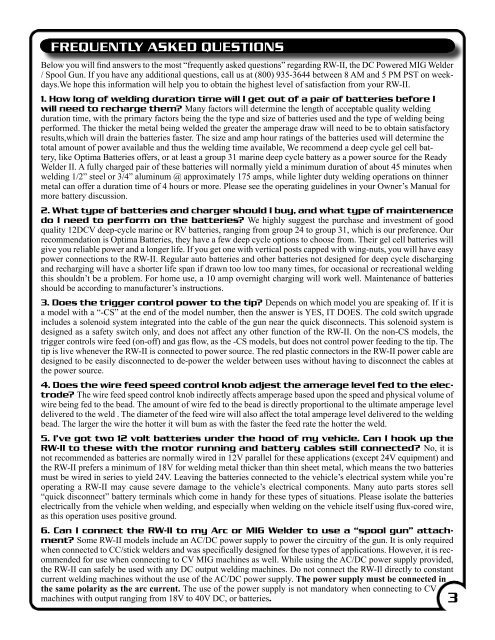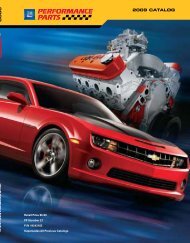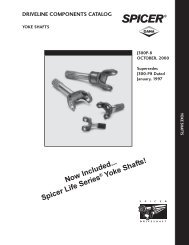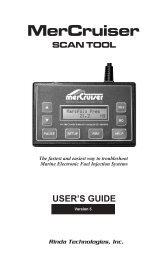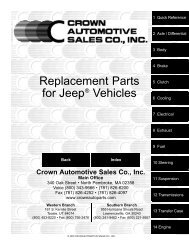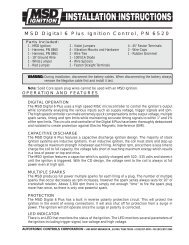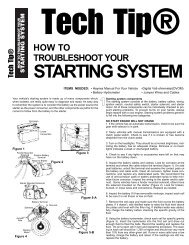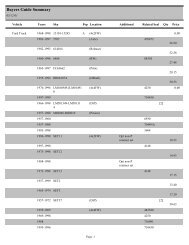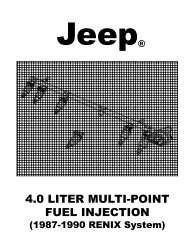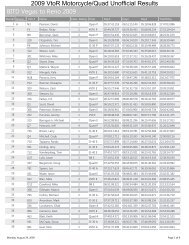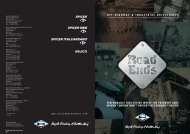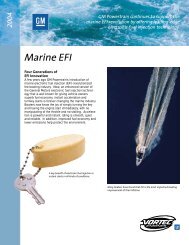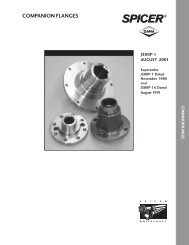Ready Welder II Operation Manual. - Pirate4x4.Com
Ready Welder II Operation Manual. - Pirate4x4.Com
Ready Welder II Operation Manual. - Pirate4x4.Com
You also want an ePaper? Increase the reach of your titles
YUMPU automatically turns print PDFs into web optimized ePapers that Google loves.
FREQUENTLY ASKED QUESTIONS<br />
Below you will find answers to the most “frequently asked questions” regarding RW-<strong>II</strong>, the DC Powered MIG <strong>Welder</strong><br />
/ Spool Gun. If you have any additional questions, call us at (800) 935-3644 between 8 AM and 5 PM PST on weekdays.We<br />
hope this information will help you to obtain the highest level of satisfaction from your RW-<strong>II</strong>.<br />
1. How long of welding duration time will I get out of a pair of batteries before I<br />
will need to recharge them? Many factors will determine the length of acceptable quality welding<br />
duration time, with the primary factors being the the type and size of batteries used and the type of welding being<br />
performed. The thicker the metal being welded the greater the amperage draw will need to be to obtain satisfactory<br />
results,which will drain the batteries faster. The size and amp hour ratings of the batteries used will determine the<br />
total amount of power available and thus the welding time available, We recommend a deep cycle gel cell battery,<br />
like Optima Batteries offers, or at least a group 31 marine deep cycle battery as a power source for the <strong>Ready</strong><br />
<strong>Welder</strong> <strong>II</strong>. A fully charged pair of these batteries will normally yield a minimum duration of about 45 minutes when<br />
welding 1/2” steel or 3/4” aluminum @ approximately 175 amps, while lighter duty welding operations on thinner<br />
metal can offer a duration time of 4 hours or more. Please see the operating guidelines in your Owner’s <strong>Manual</strong> for<br />
more battery discussion.<br />
2. What type of batteries and charger should I buy, and what type of maintenence<br />
do I need to perform on the batteries? We highly suggest the purchase and investment of good<br />
quality 12DCV deep-cycle marine or RV batteries, ranging from group 24 to group 31, which is our preference. Our<br />
recommendation is Optima Batteries, they have a few deep cycle options to choose from. Their gel cell batteries will<br />
give you reliable power and a longer life. If you get one with vertical posts capped with wing-nuts, you will have easy<br />
power connections to the RW-<strong>II</strong>. Regular auto batteries and other batteries not designed for deep cycle discharging<br />
and recharging will have a shorter life span if drawn too low too many times, for occasional or recreational welding<br />
this shouldn’t be a problem. For home use, a 10 amp overnight charging will work well. Maintenance of batteries<br />
should be according to manufacturer’s instructions.<br />
3. Does the trigger control power to the tip? Depends on which model you are speaking of. If it is<br />
a model with a “-CS” at the end of the model number, then the answer is YES, IT DOES. The cold switch upgrade<br />
includes a solenoid system integrated into the cable of the gun near the quick disconnects. This solenoid system is<br />
designed as a safety switch only, and does not affect any other function of the RW-<strong>II</strong>. On the non-CS models, the<br />
trigger controls wire feed (on-off) and gas flow, as the -CS models, but does not control power feeding to the tip. The<br />
tip is live whenever the RW-<strong>II</strong> is connected to power source. The red plastic connectors in the RW-<strong>II</strong> power cable are<br />
designed to be easily disconnected to de-power the welder between uses without having to disconnect the cables at<br />
the power source.<br />
4. Does the wire feed speed control knob adjest the amerage level fed to the electrode?<br />
The wire feed speed control knob indirectly affects amperage based upon the speed and physical volume of<br />
wire being fed to the bead. The amount of wire fed to the bead is directly proportional to the ultimate amperage level<br />
delivered to the weld . The diameter of the feed wire will also affect the total amperage level delivered to the welding<br />
bead. The larger the wire the hotter it will bum as with the faster the feed rate the hotter the weld.<br />
5. I’ve got two 12 volt batteries under the hood of my vehicle. Can I hook up the<br />
RW-<strong>II</strong> to these with the motor running and battery cables still connected? No, it is<br />
not recommended as batteries are normally wired in 12V parallel for these applications (except 24V equipment) and<br />
the RW-<strong>II</strong> prefers a minimum of 18V for welding metal thicker than thin sheet metal, which means the two batteries<br />
must be wired in series to yield 24V. Leaving the batteries connected to the vehicle’s electrical system while you’re<br />
operating a RW-<strong>II</strong> may cause severe damage to the vehicle’s electrical components. Many auto parts stores sell<br />
“quick disconnect” battery terminals which come in handy for these types of situations. Please isolate the batteries<br />
electrically from the vehicle when welding, and especially when welding on the vehicle itself using flux-cored wire,<br />
as this operation uses positive ground.<br />
6. Can I connect the RW-<strong>II</strong> to my Arc or MIG <strong>Welder</strong> to use a “spool gun” attachment?<br />
Some RW-<strong>II</strong> models include an AC/DC power supply to power the circuitry of the gun. It is only required<br />
when connected to CC/stick welders and was specifically designed for these types of applications. However, it is recommended<br />
for use when connecting to CV MIG machines as well. While using the AC/DC power supply provided,<br />
the RW-<strong>II</strong> can safely be used with any DC output welding machines. Do not connect the RW-Il directly to constant<br />
current welding machines without the use of the AC/DC power supply. The power supply must be connected in<br />
the same polarity as the arc current. The use of the power supply is not mandatory when connecting to CV<br />
machines with output ranging from 18V to 40V DC, or batteries.<br />
3


